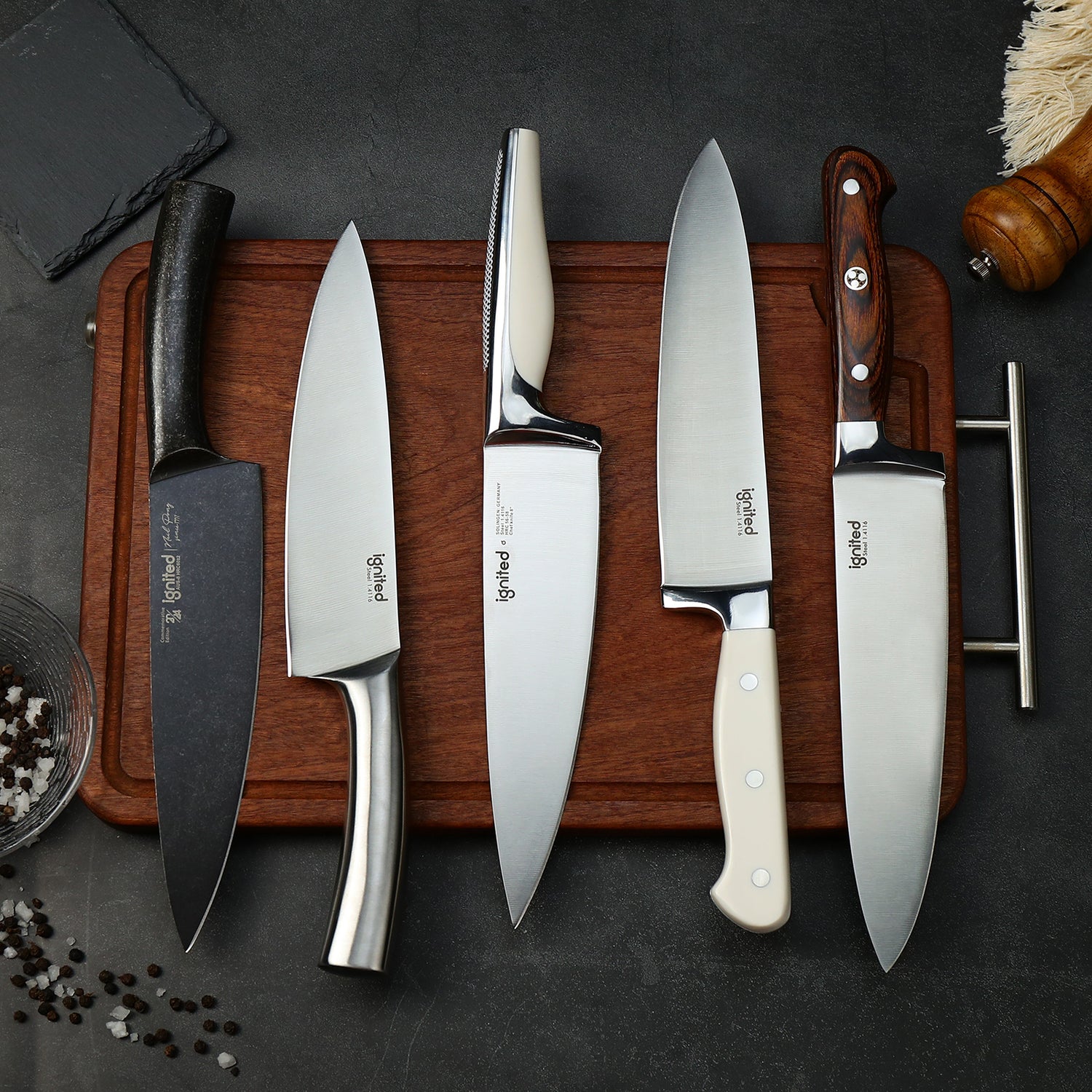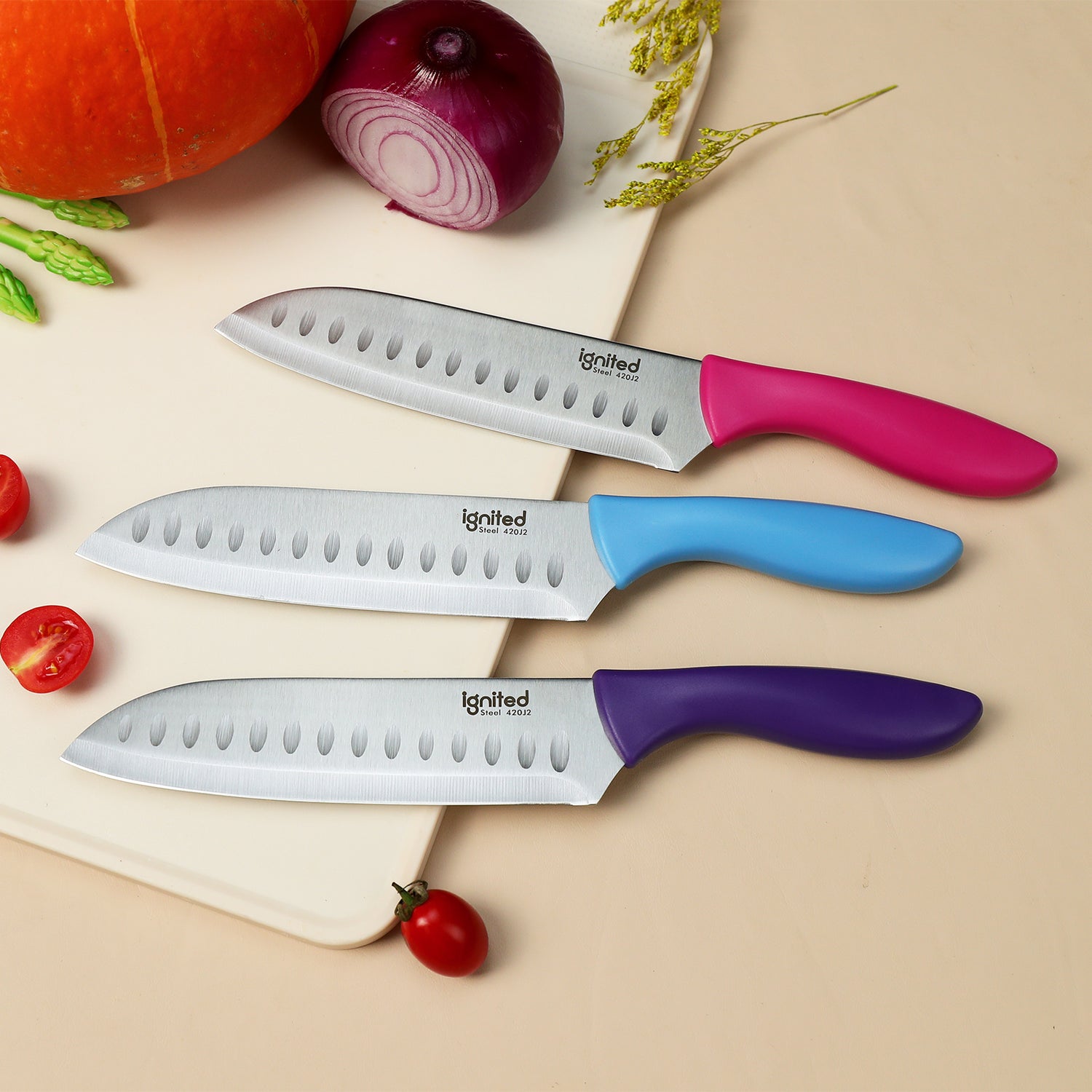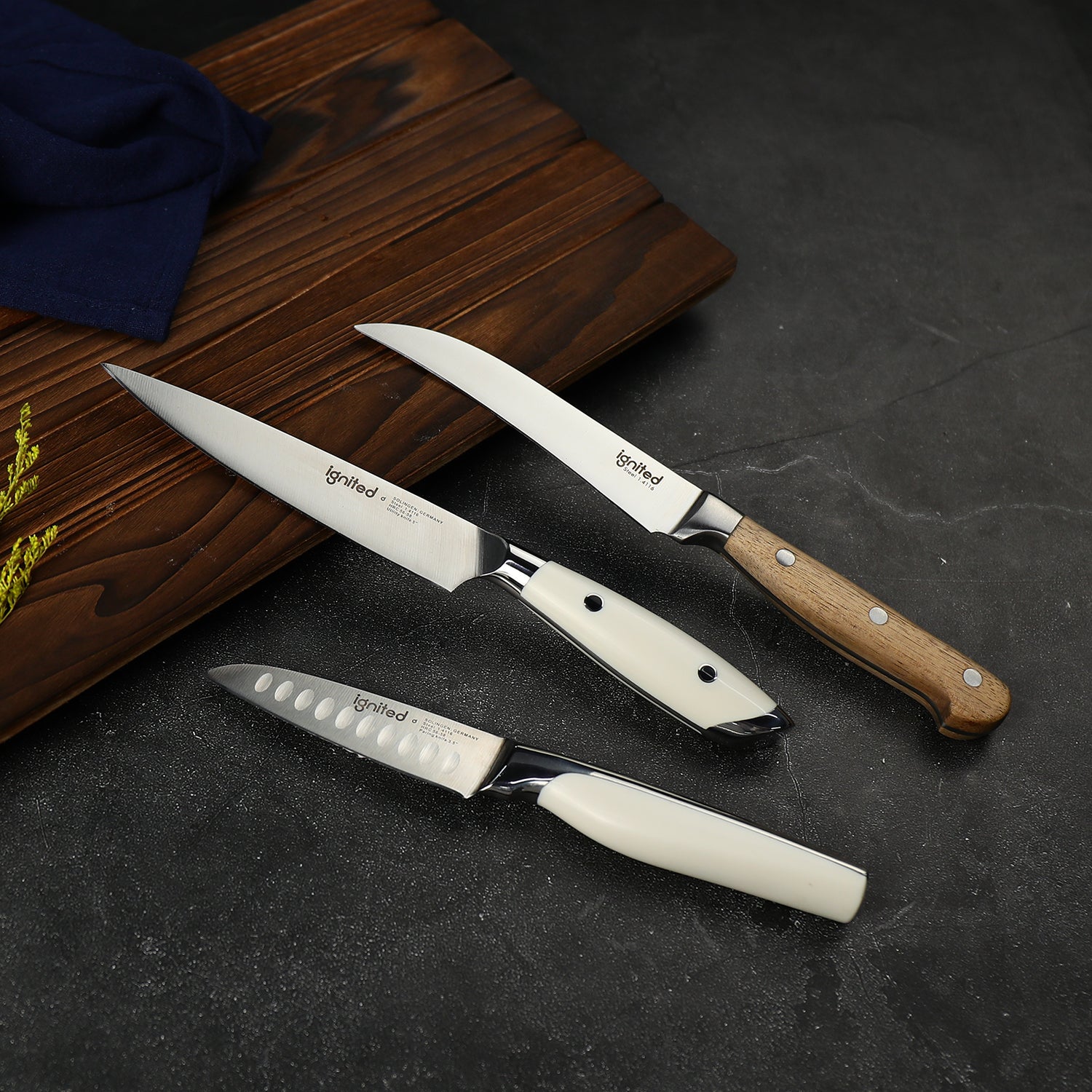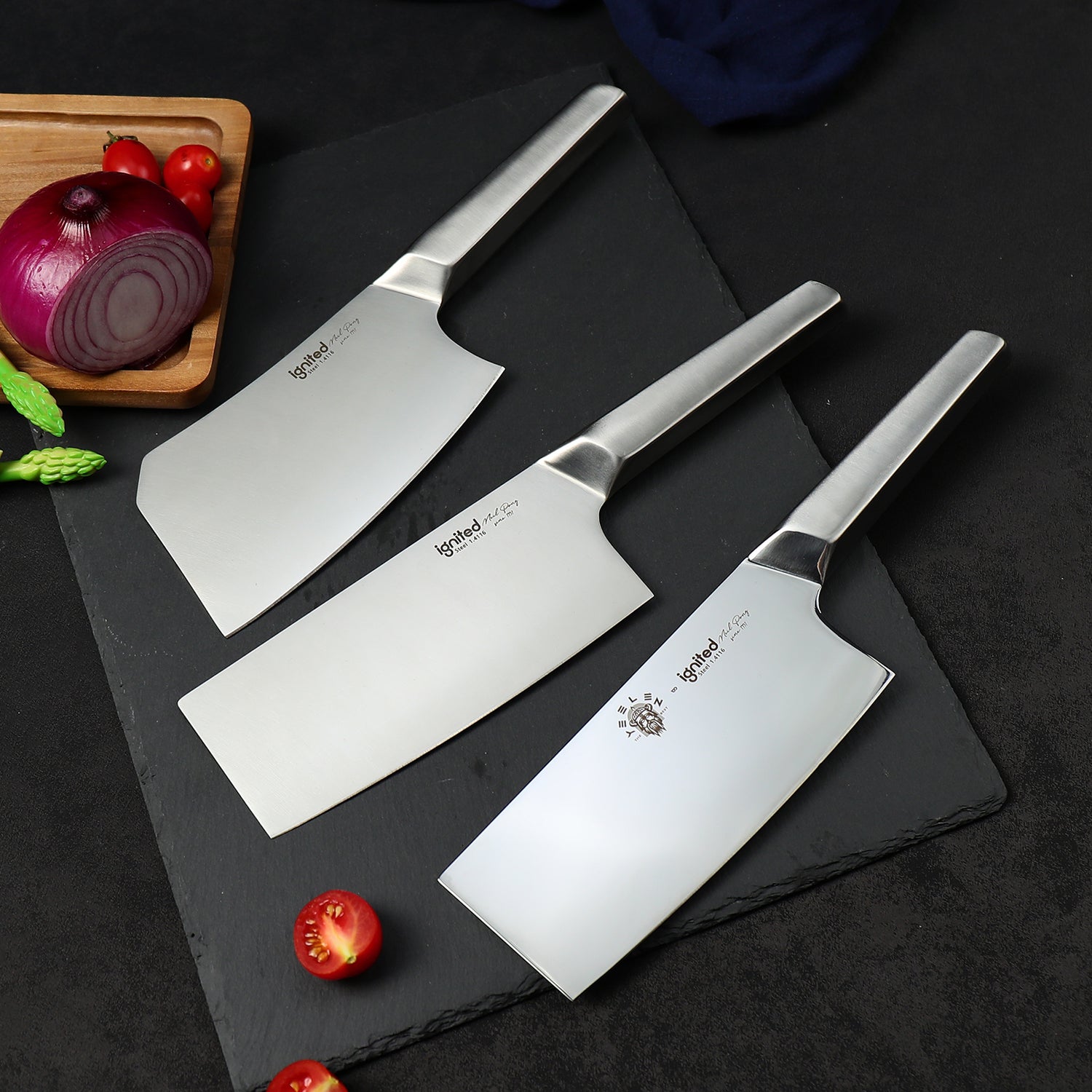What Oil To Use on Wooden Knife Handles
Understanding Wooden Knife Handles
Wood handles look great and feel warm in the hand, but they are porous and respond to moisture, oils from hands, heat and cleaning. Proper finishing and periodic maintenance keep the handle stable, comfortable and hygienic — and they extend the life of the handle.
Types of Oils for Wooden Knife Handles
Below are commonly recommended finishes — pros, cons, and food-safety notes.
1. Food-Grade Mineral Oil
- Pros: Inexpensive, non-toxic, colourless, easy to apply, won't go rancid.
- Cons: Surface protection is temporary — needs frequent reapplication (every few months).
- Best for: quick, safe maintenance. Look for USP or "food-grade" labeling.
2. Pure Tung Oil (100% Tung)
- Pros: Penetrates and cures to a tough, water-resistant finish; enhances grain.
- Cons: Slower to cure; multiple thin coats required; more costly.
- Best for: long-lasting protection when fully cured. Use only pure tung oil labeled food-safe.
3. Walnut Oil (Food-Safe)
- Pros: Natural, food-safe, attractive warm finish; used traditionally on culinary woods.
- Cons: Can oxidize and become slightly tacky or rancid over time; not suitable where nut allergies are a concern.
- Best for: artisan handles when nut-allergy risk is managed.
4. Linseed Oil (Raw vs Boiled)
- Pros: Enhances color and grain (raw dries slowly).
- Cons: "Boiled linseed oil" often contains chemical dryers — avoid unless the product is explicitly labeled food-safe. Raw linseed takes a long time to cure and may remain tacky.
- Best for: furniture (not usually ideal for food tools unless using a food-safe, polymerized linseed product).
5. Danish Oil & Other Blends
- Pros: Often gives a low-sheen, durable surface (oil + varnish blend).
- Cons: Many commercial Danish oils contain varnishes or solvents that are NOT food-safe. Only use products explicitly labeled safe for food contact.
- Best for: decorative handles — check label carefully before applying to kitchen knives.
6. Beeswax & Oil Blends (Board Balms)
- Pros: Great surface protection and water beading; pleasant feel.
- Cons: Mostly surface protection — reapply periodically.
- Combine with mineral oil or tung oil for best results.
How to Apply Oil to Wooden Knife Handles
Follow these steps for a reliable finish.
- Clean and dry: Wipe the handle with a damp cloth to remove dirt; let it dry completely.
- Light sand (optional): If the handle is rough or has old sticky finish, lightly sand with 320–400 grit paper along the grain and remove dust.
- Apply a thin coat: Put a few drops of oil on a lint-free cloth and rub along the grain until the wood accepts it.
- Wait & repeat: Let absorb 10–30 minutes (or as product instructions state). Wipe off excess. For oils like tung, apply 2–4 thin coats, allowing cure time between coats.
- Finish with wax (optional): For added surface protection, rub on a thin beeswax/oil balm and buff after it sets.
- Cure time: Allow the handle to rest until the oil is no longer tacky. For curing finishes (pure tung), follow manufacturer curing times before heavy use.
Important: Always follow the product label. When in doubt, choose a product explicitly labeled "food-safe" or "safe for food contact."
Maintenance Tips for Wooden Knife Handles
- Re-oil frequency: typically every 2–6 months depending on use, climate and how often the handle is washed/wiped.
- Daily care: avoid soaking or dishwashing the knife, dry the handle after use, and wipe off oils or food residue.
- Sticky handle fix: remove surface oil with a clean cloth, clean with a 1:1 vinegar/water wipe, dry, lightly sand if needed, and reapply a thin coat of food-safe oil.
- Deep repair: for cracks or loose ferrules consult a professional — do not force glue or heavy finishes that contact food unless food-safe.
Additional Considerations
- Allergy note: If you or your customers have nut allergies, avoid walnut oil and disclose finishes used.
- Cosmetics vs protection: Some finishes look great but don’t penetrate — prefer penetrating oils for long-term protection of the wood core.
- Heat & UV: Don’t store knives near radiators or in direct sun — heat and UV can dry and fade wooden handles even if oiled.
- Commercial finishes: Some shop finishes (polyurethane, lacquer) are durable but often not labeled food-safe — don’t use them on kitchen tools unless certified.
The Importance of Choosing Food-Safe Oils
Because knife handles may touch food or hands that then touch food, select finishes that are non-toxic and intended for food contact. Preferred options for kitchen knives include:
- USP food-grade mineral oil
- 100% pure tung oil labeled food-safe after cure
- Food-safe walnut oil (avoid if nut allergies are a concern)
- Beeswax & mineral oil blends formulated for cutting boards/utensils
Do not use: cooking oils like olive, vegetable, or canola as long-term finishes — they oxidize and become rancid. Also avoid boiled linseed oil or varnish blends unless the manufacturer explicitly states the product is safe for kitchen/food use.
FAQ
1. Can I use olive oil on my wooden knife handles?
A short wipe with olive oil is fine in a pinch, but as a long-term finish it can go rancid and create sticky, smelly handles. Use stable, food-safe finishing oils instead.
2. How often should I apply oil to my wooden knife handles?
Typical home use: every 2–6 months. Reapply sooner in dry climates or when the wood looks dull, rough or dry.
3. What should I do if my wooden knife handle feels sticky?
Wipe off excess oil, clean with a vinegar/water solution, dry, lightly sand with fine grit if necessary, and reapply a thin, even coat of food-safe oil. Avoid adding more oil until the tackiness is removed.
4. Is it safe to use mineral oil on kitchen knives?
Yes — food-grade (USP) mineral oil is non-toxic and commonly used for cutting boards, utensils and handles. It’s an excellent, safe baseline finish.
5. How can I tell when my wooden knife handle needs more oil?
Signs: the wood looks faded or dry, feels rough to the touch, or water no longer beads on the surface. Those are cues to re-oil.
Conclusion
For most kitchen knife handles the simplest, safest route is a food-grade mineral oil for routine maintenance, paired with periodic applications of a longer-lasting finish such as 100% pure tung oil or a beeswax/mineral-oil balm when you want more surface protection. Always choose products labeled safe for food contact, avoid cooking oils, and keep a light maintenance schedule — clean, dry, oil, repeat.





